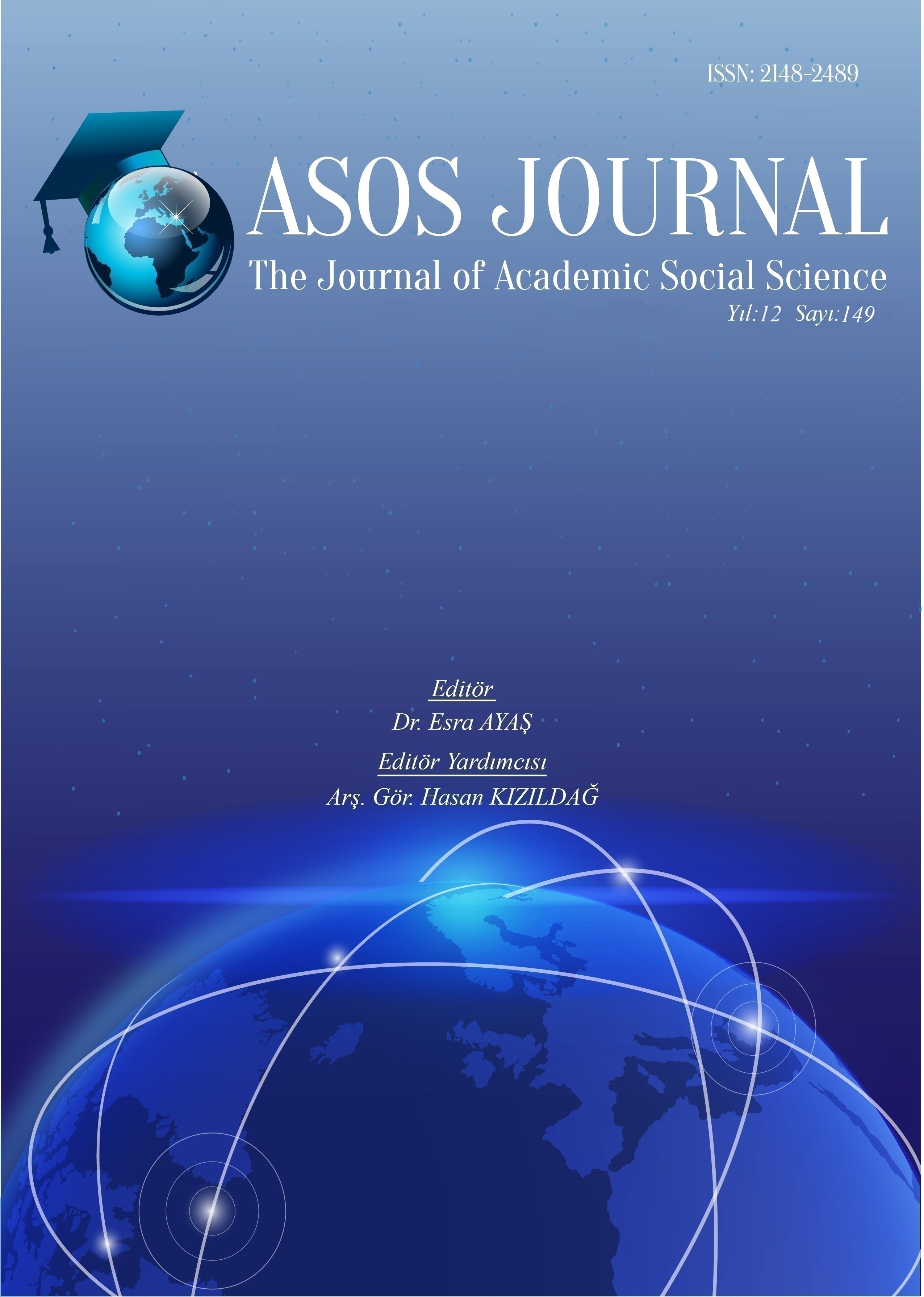ELÂZIĞ VE DİYARBAKIR İLLERİNDE OYNANAN ÇEPİK OYUNUNUN HAREKET VE MÜZİK BAĞLAMINDA KARŞILAŞTIRMALI ANALİZİ
Author :
Abstract
Türk halk oyunları coğrafi, tarihsel, kültürel ve sanatsal geçmişi ile Anadolu’nun önemli kültürel unsurlarından biridir. Geçmişten günümüze uzun bir sürece yayılarak varlığını sürdüren Türk halk oyunlarını oluşturan oyunlar ele alındığında bu oyunların bağlı olduğu toplumun kültürel kodlarından ve yaşantılarından meydana geldiği görülmektedir. Bu şekilde önemli kültürel ögeleri barındıran oyunlardan biri çepik oyunudur. Coğrafi olarak sınırları bulunan Elâzığ ve Diyarbakır illerinde görülen çepik oyununun müzikal yönü kısmen birbirine benzer olsa da farklı hareket ve duygular içerdiği tespit edilmiştir. Ayrıca her iki ilde oynandığı şekli ile ritim yapıları ele alındığında Elâzığ çepik oyununun ağırdan başlayıp hızlandığı ve sonra tekrar ağırlaşıp ardından tekrar hızlanarak devam ettiği; Diyarbakır çepik oyununun ise sabit bir ritim yapısına sahip olduğu belirlenmiştir. Bu çalışmada her iki ilde de oynandığı görülen çepik oyunun hareket ve müzikal analizi yapılmıştır. Makalenin merkezinde Elâzığ ve Diyarbakır illerinde oynanan çepik oyununun karşılaştırmalı analizi bulunmaktadır. Bunun için hareketlerin benzerlikleri ve farklılıkları ile müziksel unsurlardaki paralellikler ve ayrılıklar incelenmiş; böylece oyuna dair her iki yörenin kültürel ve toplumsal bağlamdaki özgünlükleri ortaya konmuştur. Ayrıca analizi oluşturan etmenler bir tablo ile gösterilmiştir. Çepik oyunlarının hareket analizi yapılırken oyunlar; vücut, ayak ve kolların yaptığı hareketler bağlamında ele alınıp hareket sayılarına göre anlatılmıştır. Oyunların hareket anlatımı tamamlandıktan sonra da oyunun notası eklenmiştir. Daha sonra ise müzik analizi yapılarak eser içerisinde kullanılan makam dizisine ve eseri oluşturan seslere yer verilmiştir. Çalışmanın amacı, Türk halk oyunlarının en yaygın olarak oynanan oyunlarından biri olan çepik oyununun hareket çözümlemelerinin yapılması, öğrenilmesi ve öğretilmesinin kolaylaştırılmasını sağlamaktır. Yöntem olarak yapısal hareket analiz yöntemi izlenmiştir. Kapsam olarak ise Elâzığ ve Diyarbakır illerinde oynanan çepik oyunu mercek altına alınmış; ardından bu oyunların karşılaştırmalı analizi yapılarak yorumlanmıştır. Yapılan araştırmanın neticesinde Elâzığ ve Diyarbakır yörelerinde oynanan çepik oyunlarının analizinde önemli sonuçlara ulaşılmıştır. Elâzığ ilinde görülen çepik oyununun bir ekip/topluluk tarafından değil iki erkek veya kadın tarafından oynandığı; coşku ve sevinç duygularını öne çıkardığı anlaşılmıştır. Diyarbakır ilinde oynanan çepik oyununun ise topluluk/ekip tarafından oynandığı ve kavga, çekişme duygularını aksettiği tespit edilmiştir.
Keywords
Abstract
Turkish folk dances are one of the important cultural elements of Anatolia with their geographical, historical, cultural and artistic background. When the games that make up Turkish folk dances, which have continued their existence over a long period from past to present, are considered, it is seen that these games consist of the cultural codes and lives of the society to which they are affiliated. One of the games that contain such important cultural elements is the chepik game. Although the musical aspect of the chepik dance, which is seen in the geographically bordered provinces of Elazığ and Diyarbakır, is partially similar, it has been determined that it contains different movements and emotions. In addition, when the rhythm structures of the Elazığ chepik game as played in both provinces are considered, it is seen that the Elazığ chepik game starts slowly, gets faster, and then gets slower again, and then continues to get faster again; It has been determined that Diyarbakır chepik game has a fixed rhythm structure. In this study, movement and musical analysis of the chepik game, which is seen to be played in both provinces, was made. At the center of the article is the comparative analysis of the chepik game played in Elazığ and Diyarbakır provinces. For this purpose, the similarities and differences of movements and the parallels and differences in musical elements were examined; Thus, the uniqueness of the game in the cultural and social context of both regions has been revealed. Additionally, the factors that make up the analysis are shown in a table. While analyzing the movements of Chepik games; It is discussed in the context of the movements made by the body, feet and arms and explained according to the number of movements. After the movement description of the games was completed, the game notes were added. Then, a musical analysis was made and the maqam sequence used in the work and the sounds that make up the work were included. The aim of the study is to facilitate movement analysis, learning and teaching of the chepik game, one of the most widely played Turkish folk dances. Structural motion analysis method was followed as the method. In terms of scope, the chepik game played in Elazığ and Diyarbakır provinces has been examined; Then, these games were interpreted by making a comparative analysis. As a result of the research, important results were reached in the analysis of chepik games played in Elazığ and Diyarbakır regions. The chepik game seen in Elazığ province is played by two men or women, not by a team/community; It has been understood that it highlights feelings of enthusiasm and joy. It has been determined that the chepik game played in Diyarbakır province is played by the community/team and reflects the feelings of fight and conflict.





